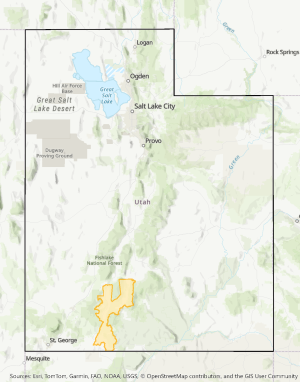Gar-Kane Rabbitbrush Strategic Fund Pool
Increase plant productivity and health by reducing plant pest pressure.
Project Description
Rabbitbrush is one of the most common invasive species on all land uses, especially range land, in Garfield and Kane Counties. This highly invasive species is affecting the health of the rangeland. The overall goal of this proposal is to increase plant productivity and health and reduce plant pest pressure by doing range improvements on 200 acres per year for the next 5 years.

- County or Counties: Garfield and Kane Counties
- Year active: FY 2023
- Duration: 5 years
Partners
Kane County Conservation District, Canyonlands Conservation District, Upper Sevier Conservation District, Kane County Weed Board, Garfield County Weed Board, Color Country Cooperative Weed Management Area.
Conservation practices involved
- Brush Management (314)
- Herbaceous Weed Treatment (315)
- Conservation Cover (327)
- Sediment Basin (350)
- Pond (378)
- Windbreak/Shelterbelt Establishment and Renovation (380)
- Fence (382)
- Woody Residue Treatment (384)
- Woody Residue Treatment (384)
- Riparian Herbaceous Cover (390)
- Wildlife Habitat Planting (420)
- Irrigation Reservoir (436)
- Access Control (472)
- Mulching (484)
- Tree/Shrub Site Preparation (490)
- Obstruction Removal (500)
- Livestock Pipeline (516)
- Pond Sealing or Lining – Geomembrane or Geosynthetic Clay Liner (521)
- Pond Sealing or Lining – Flexible membrane (521A)
- Pond Sealing or Lining – Soil Dispersant (521B)
- Pond Sealing or Lining – Bentonite Sealant (521C)
- Pond Sealing or Lining – Compacted Clay Treatment (521D)
- Prescribed Grazing (528), Pumping Plant (533)
- Range Planting (550)
- Spring Development (574)
- Livestock Shelter Structure (576)
- Structure for Water Control (587)
- Pest Management Conservation System (595)
- Tree/Shurb Establishment (612)
- Watering Facility (614)
- Water Well (642)
- Restoration of Rare or Declining Natural Communities (643)
- Upland Wildlife Habitat Management (645)
- Structures for Wildlife (649)
When to Apply
Program applications are accepted on a continual basis. However, NRCS establishes application ranking dates for evaluation, ranking and approval of eligible applications. Applications received after the ranking date will be automatically deferred to the next funding period.
Local Working Group Meetings
Every year, NRCS hosts Local Working Group meetings where farmers, landowners, conservation partners and other members of the community discuss the natural resource needs for the county. Based on feedback from those meetings, NRCS updates the county's Local Resources Assessment Priorities (LRAP) and develops new Conservation Implementation Strategies to address those resource concerns. You may contact us anytime to express concerns or comments about conservation needs in the county, and we encourage you to attend the next Local Working Group meeting in your county. For more information about Local Working Group meetings, contact your local NRCS office, or visit our Utah State Technical Committee page.
Locally Led Conservation
At the Natural Resources Conservation Service of Utah, we understand effectively partnering with our local, county and state agencies and organizations is paramount to our mission of conserving our natural resources and helping people help the land. Utah’s diverse landscape and resource needs require strategic funding and focused efforts to support locally led conservation on the ground.
Learn more about Utah's Focused Opportunities and how NRCS is utilizing SFPs to target locally identified high priority natural resource concerns and work toward a desired outcome.

